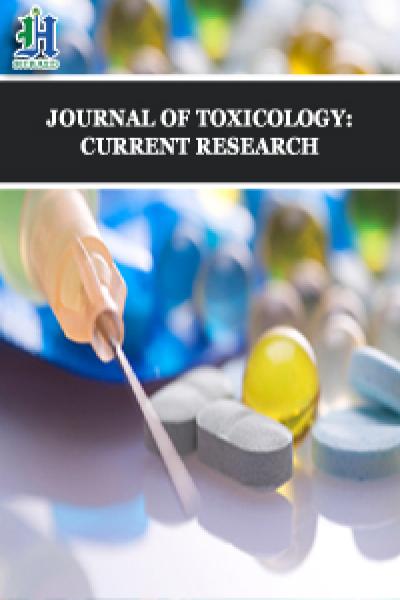
Occupational Exposure of Formaldehyde at Some Mortuaries in the Ashanti Region of Ghana
*Corresponding Author(s):
Asare-Donkor NKDepartment Of Chemistry, Kwame Nkrumah University Of Science And Technology Kumasi, Ghana
Tel:+233 205377408,
Email:asaredonkor@yahoo.co.uk
Abstract
Formaldehyde is the main ingredient in embalming liquids used in mortuaries for preserving bodies. Due to its carcinogenicity, it has raised questions about the occupational health of workers in health facilities that work with formaldehyde. This poses health risk to morticians, hospital workers and mortuary workers. This study measures the formaldehyde levels both indoor and outdoor at some selected mortuaries in the Ashanti region of Ghana. Air samples were taken from various rooms, corridors and immediate environment of these mortuaries using the 3-methyl-2-benzothiazolinone hydrazine hydrochloride method. Temperature and relative humidity were also measured and a survey on the potential formaldehyde sources in these facilities and health effects were administered to respondents at the same time. The levels of formaldehyde recorded for mortuaries in this study ranged between 14-710µg/m3. Temperature and relative humidity were positively correlated with the level of formaldehyde (p=0.003). Workers in the mortuaries complained of symptoms such as eye irritation, nose and throat irritations, headaches and sometimes vomiting. These symptoms are related to specific place of activity within the facility and how frequent a particular worker visits or comes to work weekly. The hazard quotient values calculated ranged from 0.1 to 5.2.
Keywords
Formaldehyde exposure; Hazard quotient; Health; Indoor air quality; temperature
INTRODUCTION
Formaldehyde is a compound that occurs naturally in the environment and it is the most abundant aldehyde. Formaldehyde is the colourless, harmful and readily polymerised gas at normal room temperature. It has a sharp, strong and irritating odour [1].
Formaldehyde, through oxidation of hydrocarbons, can be formed naturally in the troposphere. It has a molecular weight of 30.03 and soluble in ethers and alcohols and also soluble in water around 400g/Lat 20°C [2]. Formaldehyde can readily polymerise to a 65-75% formaldehyde air mixture in the presence of air and moisture at room temperature which is readily flammable [3]. At temperatures above 150°C, formaldehyde decomposes into methanol and carbon monoxide and under atmospheric conditions, formaldehyde is photo- oxidized in sunlight to carbon dioxide.
Commercially, formaldehyde is produced from methanol. A metal catalyst which copper was previously used but currently, silver is used in a primary methanol oxidation process in producing formaldehyde. In this process, partial oxidation and dehydrogenation with air is carried out in the presence of silver crystals serving as the catalyst and steam excess at 600-650°C. Formaldehyde is produced industrially worldwide and it finds its use in the manufacture of disinfectants and fixatives, germicides, insecticides or as a preservative in lots of consumer products. It is observed that new buildings with relative humidity and high temperatures have high levels of formaldehyde but these levels diminish after several months [4]. In mortuaries and funeral homes, formaldehyde has been used as preserving and embalming agent since its tissue-hardening properties were discovered [2]. During the course of their work, embalmers are exposed to formaldehyde. Indoor air in these facilities may be polluted as a result of the release of formaldehyde from bodies that are preserved with embalming liquids containing formaldehyde [5]. Personal exposures to formaldehyde in mortuaries have been documented as 615 to 10725.6µg/m3 in a research conducted in the United States of America [2]. Morticians in mortuaries, certain health care professionals, laboratory technicians and mortuary employees may be exposed to higher levels of formaldehyde than the general public due to their exposure to embalmed bodies.
Air pollution occurs when gases, dust particles, fumes or smoke or odour are introduced into the atmosphere in a way that makes it harmful to living organisms. Pollution of the environment has become one of the major problems the world has been battling with currently. Pollution generally has damaging effects on both living things and the environment. Primary sources of indoor air pollution include bio aerosols and volatile organic compounds which include benzene and formaldehyde. When primary pollutants in the air mix up in a chemical reaction, they form more harmful chemicals such as smog and ozone [6]. The effects of air pollution are alarming as they are known to cause several respiratory and heart conditions along with cancer, pneumonia, asthma and even death [7].
Health effects and toxicity of formaldehyde
There are reports in research studies that short term exposure to formaldehyde can cause eye, nose, throat and skin irritations whereas long term exposure has been associated with certain cancers as well as asthma. In the upper respiratory tract, irritation effects begin at concentrations as low 0.1 ppm but these effects become more prevalent at concentrations of 0.2ppm [8]. Symptoms in the lower airways such as cough, chest tightness, and wheeze are observed at concentrations above 5ppm, but some of these symptoms may occur in the presence of fine particles at lower concentrations of 0.07ppm [8]. To protect the population from the health effects of formaldehyde several safety and occupational health authorities worldwide have proposed permissible exposure levels of formaldehyde through inhalation. They have set occupational Threshold Limit Values (TLV) which are generally categorized as Time-Weighted Average (TWA), Short Term Exposure Limit (STEL) and Ceiling (C) values. Ceiling values define the exposure limit which should not be exceeded at any time [9]. The STEL and permissible exposure limit rime-weighted average (PEL-TWA) set by Occupational Safety and Health Administration (OSHA) for formaldehyde is 2ppm in15 minutes and at 0.75ppm respectively. World Health Organization (1989) recommends that indoor formaldehyde concentration should be 0.08ppm whereas California Air Resources Board recommends a target level of 0.05ppm for homes but such guidelines are not available in Ghana. Khoderetal [10], reports a level of 0.100ppm of formaldehyde in older homes and0.147ppm in newer homes in a research conducted in Greater Cairo which are all above the recommended limits set by health organizations. There is the need to investigate this in Ghana since data for formaldehyde emission are needed for setting standards of indoor exposures, health risks, and measures for reducing risk in Ghana.
METHODOLOGY
Sampling areas
Study area and sampling sites: The Republic of Ghana is located along the Gulf of Guinea and Atlantic Ocean in the sub- region of West Africa with a projected population of 24,658,823 [11]. It comprises of ten regions of which the Ashanti region is one of them. The Ashanti region is the study area in which this research was conducted. The Kumasi metropolis which is the capital city of the Ashanti region is the most populous in the region [11]. This region is made up of twenty-seven districts with a total population of 4,780,380. The Ashanti region has an area size of about 24,389km2 and population density of 196.01inh/km2. This population is made up of 2,316,052males and 2,464,328 being females. The region is one of the fastest growing regions in the country due to urbanization [11].
Sampling sites included hospitals with mortuaries, or private mortuaries that provided the same service, offices and residential homes. Ashanti region has both government and private hospitals with mortuaries. This research focused on residential homes, offices and mortuaries located in the Ashanti region. The culture and traditions of Ashantis allows them to attach lots of importance to paying their last respect to the dead. Private and government offices both new and old and residential facilities are also available because of the economic activities that takes place in this region. Districts in which samples were collected were based on random sampling because not all towns based in each district have mortuaries or hospitals with mortuaries.
Homes and offices in which samples were collected from was based on the approval that was given by the participants after the purpose of this research was made known to them. In mortuaries such as the Komfo Anokye Teaching Hospital (KATH) which is located at Bantama in Kumasi, air samples were taken from two histopathology laboratories, autopsy laboratory, corridors leading to these laboratories and the corridor that sits just in front of the mortuary. In private mortuaries such as Plus laboratory mortuary and Konadu Yiadom mortuary located at Mankranso in the Ahafo Ano south district and Adako Jachie in the Ejisu municipality respectively, they did not have laboratories but had embalming rooms and preparation rooms for preparing dead bodies. Other Government mortuaries that samples were taken from include the Bekwai Government hospital and the Kwame Nkrumah University of Science and Technology School of Medical Sciences mortuary (Map).
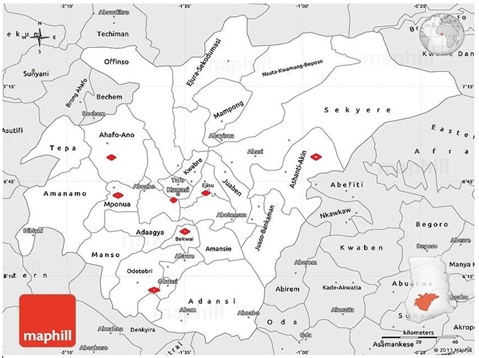
Air samples were taken from embalming rooms, morgue areas and rooms in which bodies were finally cleaned and prepared for family to carry away. Corridors leading to all these rooms and areas were sampled. Air samples were also taken from the immediate environment of these mortuaries and labelled as outdoor. With regards to residential homes, air samples were taken from kitchen, bedrooms, halls and corridors in these homes. Homes that had no residents were not sampled. Offices of schools, government and private facilities formed part of the sampling sites. Each town that was visited had a mortuary either government or private or both and as a result samples were also taken from residential homes and offices located in that town.
The sampling area involved five different health/mortuary facilities in the Ashanti region of Ghana. Namely Komfo Anokye Teaching Hospital, Plus lab mortuary, Konadu Yiadom mortuary, Bekwai Government mortuary and Kwame Nkrumah university of Science and Technology School of Medical Sciences mortuary (Table 1).
Five different air samples were taken from KATH mortuary, autopsy laboratory, histopathology laboratories and the corridors that lead to these laboratories/departments. Four air samples were taken from the morgue Plus Lab Mortuary (This is a private mortuary that has existed for less than a year.). A total of five different samples were taken from the Konadu Yiadom Mortuary (a private mortuary). Air samples were taken from various divisions within the School of Medical Sciences mortuary, KNUST. Air samples that were taken from the Bekwai Government Hospital Mortuary facility.
Sampling
Indoor and outdoor measurements of formaldehyde concentrations were made at five different mortuaries in the Ashanti region. Some information gathered from the survey about the sampling site is shown in table 1. Air samples were collected from embalming rooms, refrigerator rooms, and corridors within the facilities, preparation rooms and outdoor environment. The indoor samples were collected at approximately 1.5m above the floor.
Chemical analysis
Reagents and instruments: Absorbing solution was prepared from 3-Methyl-2-Benzothiazolinone Hydrazine Hydrochloride (MBTH) (Sigma-Aldrich Chemie GmbH, Steinheim, Germany). Oxidizing solution was prepared from Sulfamic acid and ferric chloride. Spectrophotometry (Shimadzu mini UV/Visible Spectrophotometer model 1240, Shimadzu Corporation, Japan) was used for the determination of absorbance. The total aldehyde in air was collected in 0.05% aqueous solution of MBTH system service innovation incorporation air sampler model 1000i. Relative humidity and atmospheric pressure were measured using 433 MHz electronic weather station. The resulting azine was then oxidized by ferric chloride-sulfamic acid solution which can be measured at 628nm using spectrometry. Formaldehyde solution (DB11 Laboratory supplies, England)the concentration of total aldehyde is calculated in terms of formaldehyde. Air samples were calculated in glass impinger containing 35ml of 0.05% MBTH solution using the system service innovation incorporation air sampler model 1000i calibrated to draw 0.5L of air per minute. Sampling was done for 30minutes (15Lofair). After each sampling time, the volume of the absorbing solution was made to 35m lift here were any losses as a result of evaporation. At the same time, the temperature, relative humidity and atmospheric pressure were measured using 433MHz electronic weather station. Samples were then transferred into clean sample bottles and sealed and taken to the laboratory for analysis. Ten millimeters of sample solution were transferred in to a clean glass stopper tube washed with distilled water and equal volume of unexposed reagent and distilled water was placed in a second clean tube to serve as a blank.
Two millimeters of oxidizing solution was prepared from 1.0g of ferric chloride and 1.6g of Sulfamic acid dissolved in 100ml of distilled water was added to the sample solution and blank and mixed well. After allowing standing for at least 12minutes, the absorbance was determined at 628nm against the reagent blank using Shimadzu mini UV/visible spectrophotometer model 1240.
To prepare the calibration solution, a stock formaldehyde solution of concentration 402402mg/L was used to prepare formaldehyde standard solution of concentration 4000mg/L. Formaldehyde working standard solutions of concentrations 0.5, 1.0, 1.5, 2.0, 2.5mg/L were prepared from the formaldehyde standard solution.
To a clean tube, 5ml of 0.05% MBTH solution, 5ml of standard formaldehyde solution and 2ml of oxidizing solutions were added. This was used as a reagent blank.
A series of questions and other prompts in the form of survey were used to gather information about the facilities to know the specific materials found in these facilities that emit formaldehyde. It was also used to get information about the health conditions of workers and residents of facilities where samples were taken.
RESULTS
Temperature and relative humidity have a significant impact on the level of formaldehyde concentration since the probability value (0.003) is less than an alpha value of 0.05 (5%). The main source of formaldehyde inthese facilities is formalin solution that is used for embalming and preserving cadavers. The American Conference of Governmental Industrial Hygienist (Table 2-4).
|
Variable |
Observations |
Minimum |
Maximum |
|
Concentration (µg/m3) |
23 |
14.000 |
710.000 |
|
Temperature (°C) |
23 |
28.000 |
35.500 |
|
Relative Humidity (%) |
23 |
33.000 |
61.000 |
Table 2: Summary statistics (Quantitative data) for mortuaries.
|
Source |
DF |
Sum of Squares |
Mean Squares |
F |
Pr>F |
|
Model |
2 |
385618.597 |
192809.299 |
8.058 |
0.003 |
|
Error |
20 |
478553.142 |
23927.657 |
|
|
|
Corrected Total |
22 |
864171.739 |
|
|
|
|
Computed against modelY=Mean(Y) |
|||||
Table 3: Analysis of variance (Concentration (µg/m3)).
|
Location |
Concentration Range (µg/m3) |
|
Indoor |
80-710 |
|
Outdoor |
14.08-98.0 |
Table 4: Concentration for mortuaries (Indoor and Outdoor).
(ACGIH) has set an eight-hour workday and 40-hourswork Time Weighted Average (TWA) of 1.0 ppm for formaldehyde. The formaldehyde levels of this study for mortuaries ranged from 14µg/m3to 710µg/m3 for 30 minutes. This level is higher than the permissible limit set by ACGIH’s TWA. Although the levels were above the limits set by regulatory and health organizations, the concentration in autopsy lab, preparation room and embalming rooms may fallandriseirregularlydependingonthesiteandnumberofcadaversstoredintheroomorfreshly treated corpse. At formaldehyde concentration range of 14µg/m3 to 710µg/m3, about 95% of workers in the mortuaries that were interviewed complained of symptoms such as eye irritations, skin irritation, nose and throat irritation, headaches and sometimes vomiting. These symptoms are related to specific place of work within the facility and how frequent particular worker visits or comes to work. This finding is not different from what Chia et al. [12], reported in a research on medical students’ exposure to formaldehyde in Gross Anatomy dissection laboratory.
The indoor formaldehyde concentration range recorded for mortuaries were higher than the outdoor levels recorded. Ohmichi et al. [13], reported from a study conducted to ascertain formaldehyde exposure in a gross anatomy laboratory that personal exposure levels are higher than indoor concentration recorded. It indicates that a person close to cadavers or embalmed bodies has personal exposure level of possibly two to three times higher than the mean formaldehyde concentration recorded. This raises concern about the health of workers and level of indoor formaldehyde concentration recorded in this study for the mortuaries since the indoor levels recorded ranged from 80-710µg/m3is higher than that reported by Ohmichi et al. [13].
The concentration of formaldehyde determined from the sampled air from the various departments within the KATH mortuary ranged from 190-710µg/m3(Table 5 and Figure 1) which is greater than WHO’s permissible TWA exposure limit (100µg/m3) for formaldehyde. The main chemical used in this mortuary is formalin, and it is used to preserve dead human bodies. From figure 1, there is a small difference in the formaldehyde concentrations recorded in the histopathology laboratories and the autopsy laboratory. Slightly higher concentrations were recorded in the autopsy laboratory as compared to the two histopathology laboratories. Histopathology lab 2 has a slightly higher formaldehyde concentration and that could be attributed to the formalin that is used in the preparation chamber, poor ventilation, the malfunctioning of the fume chamber and samples with formalin which are stored in the laboratory. The corridor leading to the histopathology labs has a higher formaldehyde concentration as compared to the corridor leading to the autopsy lab. The autopsy lab has an air-tight door which is always closed making it difficult for the indoor air to escape into the corridor. Unlike the autopsy laboratory, the histopathology lab 2 which has a preparation chamber that makes use of formalin has its door left opened making it easy for the exchange of air between these two places. This could account for the slightly higher formaldehyde concentration recorded in this corridor. From the questionnaire that was administered, it is clear that all workers within this facility have some knowledge about the main chemical used daily since they had all been through some formal education. All workers interviewed complained of eye and skin irritations, two of them complained of headache and one complained of vomiting on one occasion. Forty percent (40%) of the workers interviewed were females and the remaining males. Their ages ranged from 31 to 52. The facility has been in use for more than fifteen years and as a result could be regarded as an old facility. Averagely 20 bodies are embalmed weekly using a mixture of formalin and water in a proportion of one liter of formalin to four liters of water.
|
Kath |
Concentration (µg/m3) |
|
Autopsy laboratory |
710 |
|
Autopsy corridor |
190 |
|
Histopathology laboratory 1 |
610 |
|
Histopathology laboratory 2 |
660 |
|
Histopathology corridor |
420 |
|
Range |
190-710 |
Table 5: Summary of the formaldehyde concentration at KATH mortuary.
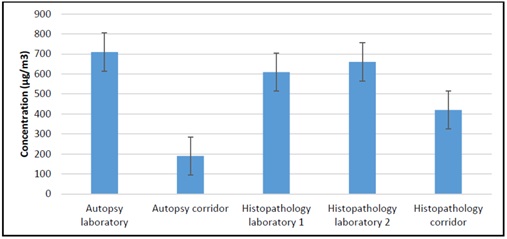 Figure 1: Departments and their levels of formaldehyde at KATH mortuary.
Figure 1: Departments and their levels of formaldehyde at KATH mortuary.
The concentration of formaldehyde determined from the sampled air taken from plus lab mortuary ranged from 27.25-270µg/m3 (Table 6 and Figure 2). The mean concentration of formaldehyde measured for this facility also exceeds the TWA permissible exposure limit (100µg/m3) for formaldehyde set by WHO. Samples were taken in the morning. Formaldehyde concentration determined for the corridor of the preparation room and embalming showed slight difference with the preparation room corridor recording a concentration of 260µg/m3and the embalming room a concentration of 270µg/m3. The set-up within plus lab mortuary makes it easy for the mix up of air between these two places since one opens into the other. The facility is new and has been in operation for the past eight months. The preparation room is where formalin is stored and used for embalmment. The preparation room is where corpses are finally prepared before family members take them away.
|
Plus Lab Mortuary |
Concentration (µg/m3) |
|
Embalming room |
270 |
|
Preparation room |
390 |
|
Corridor of Preparation room |
260 |
|
Outdoor of mortuary |
27.25 |
|
Range |
27.25-270 |
Table 6: Summary of the formaldehyde concentration at Plus lab mortuary.
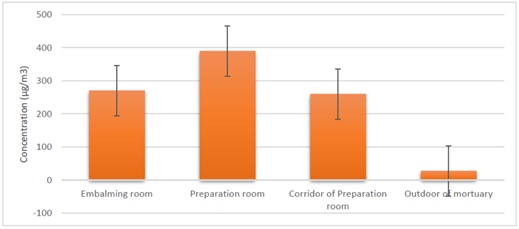 Figure 2: Departments and their levels of formaldehyde at Plus Lab mortuary.
Figure 2: Departments and their levels of formaldehyde at Plus Lab mortuary.
The concentration of formaldehyde determined from the samples taken from Konadu Yiadom mortuary ranged from 14.086-370µg/m3 (Table 7 and Figure 3). The concentration of formaldehyde measured for this facility was higher than the permissible WHO TWA exposure limit (100µg/m3) for formaldehyde. From the results it can be seen that the concentration for the corridor (370µg/m3) is far higher compared to the other places within the mortuary. The embalming room recorded a concentration of 110µg/m3. Containers of formalin used for embalming are stored on this corridor and it opens in to the refrigerating room. The outdoor has the lowest concentration of 14.086µg/m3 indicating some boundary between the indoor and outdoor air.
|
Konadu Yiadom Mortuary |
Concentration (µg/m3) |
|
Embalming room |
110 |
|
Preparation room |
80 |
|
Corridor of embalming room |
370 |
|
Refrigerator area |
108 |
|
Outdoor of mortuary |
14.08 |
|
Range |
14.086-370 |
Table 7: Summary of the formaldehyde concentration at Konadu Yiadom mortuary.
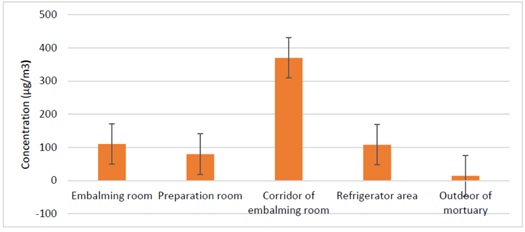 Figure 3: Departments and their levels of formaldehyde at Konadu Yiadom mortuary.
Figure 3: Departments and their levels of formaldehyde at Konadu Yiadom mortuary.
The concentration of formaldehyde determined from the sampled air from the various departments of the SMS morgue ranged from 98-262µg/m3 (Table 8 and Figure 4). The concentration of formaldehyde measured for this facility also exceeds WHO permissible TWA exposure limit (100µg/m3) for formaldehyde. The concentration of formaldehyde determined for embalming room 2 (262µg/m3) is slightly higher than embalming room 1 (186µg/m3) and this could be attributed to the better ventilation that the embalming room 1 has. It is closer to the entry which has a partially opened door. This allows exchange of air between the immediate surroundings of the embalming room 1. That could account for the lower concentration. The dissecting room’s corridor had a slightly higher formaldehyde concentration (207µg/m3) as compared to embalmingroom1 (186µg/m3). The ventilation of the corridor and the dissecting room can be described as poor since it had an enclosed area with its doors always locked. The exchange of air between the outside environment and corridor of dissecting room is not good enough. The concentration levels measured for this facility were relatively lower as compared to the other mortuaries such as KATH and Plus lab mortuary mortuaries because salt have been employed in the solution used for embalming in order to reduce the volume of formaldehyde used earlier.
|
School of Medical Sciences (SMS) |
Concentration (µg/m3) |
|
Embalming room 1 |
186 |
|
Embalming |
262 |
|
Corridor of dissecting room |
207 |
|
Outdoor of mortuary |
98 |
|
Range |
98-262 |
Table 8: Summary of the formaldehyde concentration at SMS (KNUST) mortuary.
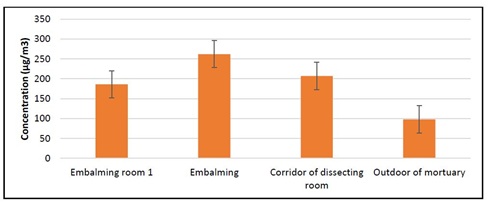 Figure 4: Departments and their levels of formaldehyde at SMS (KNUST) mortuary.
Figure 4: Departments and their levels of formaldehyde at SMS (KNUST) mortuary.
The concentration of formaldehyde determined from the sampled air from the various divisions within the Bekwai government hospital mortuary ranged from14.21-250µg/m3 (Table9, Figure 5 and 6). The concentration of formaldehyde measured for this facility also exceeds WHO 8-hour TWA exposure limit (100µg/m3) for formaldehyde. There is a slight difference between the HCHO concentrations measured in the preparation room (160µg/m3), morgue area (150µg/m3) and corridor of embalming room (140µg/m3). This indicates the formaldehyde concentrations within the facility are well mixed up since these areas did not have well defined boundaries that prevented air from moving out from one unit. The embalming area had a significantly higher concentration because this area was a bit enclosed. Very low concentration determined for the outdoor environment indicates good ventilation in the outdoor environment and boundary between the morgue facility and its surrounding.
|
Bekwai Government Hospital |
Concentration of Hcho (µg/m3) |
|
Embalming area |
250 |
|
Preparation room |
160 |
|
Corridor of embalming room |
140 |
|
Refrigerator area |
150 |
|
Outdoor of mortuary |
14.21 |
|
Range |
14.21-250 |
Table 9: Summary of the formaldehyde concentration at Bekwai Government Hospital mortuary.
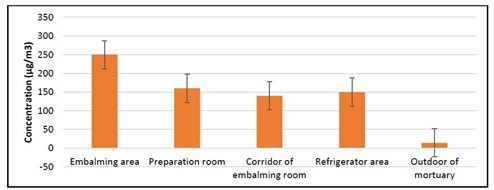 Figure 5: Formaldehyde levels at various departments at Bekwai Government Hospital mortuary.
Figure 5: Formaldehyde levels at various departments at Bekwai Government Hospital mortuary.
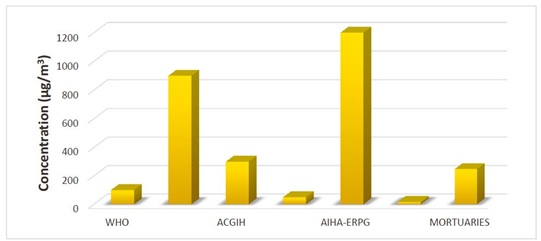 Figure 6: Permissible exposure limit by some organizations and mean level of formaldehyde from mortuaries.
Figure 6: Permissible exposure limit by some organizations and mean level of formaldehyde from mortuaries.
Non-carcinogenic human health risk
The levels of formaldehyde determined from the study were used to assess the inhalation risk for human health as workers and inhabitants of these offices and residences inhale air from these facilities. To be able to characterize the non-carcinogenic health risks for humans (Table 10).
|
Sampling Site |
Formaldehyde Concentration (µg/m3) |
Exposure Concentration (EC) |
Hazard Quotient (HQ) |
|
KATH |
|
|
|
|
Autopsy Room |
710 |
52.0 |
5.2 |
|
Autopsy Corridor |
190 |
13.9 |
1.4 |
|
Histopathology Lab 1 |
610 |
44.6 |
4.5 |
|
Histopathology Lab 2 |
660 |
48.3 |
4.9 |
|
Histopathology Lab Corridor |
420 |
30.7 |
3.1 |
|
Bekwai Gov’t Hospital |
|
|
|
|
Embalmment Area |
250 |
18.3 |
1.8 |
|
Preparation Room |
160 |
11.7 |
1.1 |
|
Morgue Area |
150 |
10.9 |
1.1 |
|
Corridor of Embalming Room |
140 |
10.2 |
1.0 |
|
Outdoor of Mortuary |
14.21 |
1.0 |
0.1 |
|
Konadu Yiadom Morgue |
|
|
|
|
Embalming Room |
110 |
8.0 |
0.8 |
|
Preparation Room |
80 |
5.8 |
0.5 |
|
Corridor of Embalming Room |
370 |
27.1 |
2.7 |
|
Morgue Area |
108 |
7.9 |
0.8 |
|
Outdoor of Mortuary |
14.086 |
1.0 |
0.1 |
|
Plus Lab Morgue |
|
|
|
|
Embalming Room/ Morgue |
270 |
19.78 |
2.0 |
|
Preparation Room |
390 |
28.5 |
2.9 |
|
Corridor of Preparation Room |
260 |
19.0 |
1.9 |
|
Outdoor of Mortuary |
27.25 |
1.9 |
0.2 |
|
SMS Mortuary (KNUST) |
|
|
|
|
Embalming Room 1 |
186 |
13.6 |
1.3 |
|
Embalming Room 2 |
262 |
19.1 |
1.9 |
|
Corridor of Dissecting Room |
207 |
15.1 |
1.5 |
|
Outdoor of Mortuary |
98 |
7.1 |
0.7 |
Table 10: Hazard quotient values for mortuaries.
Calculations of Hazard Quotient (HQ), which is defined as the relation between the predicted exposure concentration and the inhalation reference dose (RfDinh) were done. The RfDinh value of 9.83μg/m3used to calculate HQ was taken from a document of the United States Environmental Protection Agency [14]. The hazard quotient values calculated ranged from 0.1 to 5.2.
CONCLUSION AND RECOMMENDATIONS
Formaldehyde levels that were determined for mortuaries were generally high. The Autopsy lab at KATH recorded the maximum concentration of 710μg/m3whereas the outdoor environment of Bekwai Government Hospital recorded the minimum concentration of formaldehyde of 14μg/m3.
The results from the mortuaries suggest that workers in these sampled areas are at a higher risk of being exposed to the effects of formaldehyde. Temperature and relative humidity correlated positively with levels of formaldehyde concentration all mortuary facilities that were studied.
The concentration of formaldehyde recorded for mortuaries ranged between14 and 710µg/m3. These concentrations that were measured are above the World Health Organization (WHO) permissible limit of100µg/m3foreighthours working period and these also exceed the chronic and acute reference exposure limit set by the Office of Environmental Health Hazard Assessment (OEHHA) for prevention of health risk to humans at 55µg/m3and 9µg/m3respectively.
Occupational safety standards and regulations at the various facilities should be monitored and enforced whilst adequate protective equipment and materials should be made readily available to the employees who work in these facilities.
ACKNOWLEDGEMENT
The authors wish to acknowledge the assistance of Professor (Mrs) Chrissie Stansie Abaidoo, Head of Anatomy Department at the School of Medical Sciences, Kwame Nkrumah University of Science and Technology and Mr Samuel Duodu, Head of Komfo Anokye Teaching Hospital mortuary for his assistance and directions that helped me to successfully perform the performance of the experimental work at Komfo Anokye Teaching Hospital.
COMPLIANCE WITH ETHICAL STANDARDS
Not Applicable.
CONFLICT OF INTERESTS
The authors declare that they have no conflict of interests.
REFERENCES
- National Cancer Institute (2016) Formaldehyde and cancer risk. National Cancer Institute,Maryland, USA.
- Mao C (1994) Formaldehyde use reduction in mortuaries.Doctoral dissertation, University of Massachusetts Lowell, Massachusetts, USA.
- World Health Organization (1989) International programme on chemical safety: Formaldehyde. environmental health criteria 89. World Health Organization, Geneva, Switzerland.
- Haghighat, F, De Bellis L (1998) Material emission rates: Literature review, and the impact of indoor air temperature and relative humidity. Building and Environment 33: 261-277.
- Stewart PA, Herrick RF, Feigley CE, Utterback DF, Hornung R, et al. (1992) Study design for assessing exposures of embalmers for a case-control study. Part I. monitoring results. Applied Occupational and Environmental Hygiene 7: 532-540.
- National Institute of Environmental Health Sciences (2016) Air pollution. National Institute of Environmental Health Sciences, North Carolina, USA.
- Kuwabara Y, Alexeeff GV, Broadwin R, Salmon AG (2007)Evaluationandapplication of the RD50 for determining acceptable exposure levels of air born sensory irritants for the general public. Environ Health Perspect 115: 1609-1616.
- Liu KS, Huang FY, Hayward SB, Wesolowski J, Sexton K (1991) Irritant effects of formaldehyde exposure in mobile homes.Environ Health Perspect 94: 91-94.
- Salthammer T, Mentese S, Marutzky R (2010) Formaldehyde in the indoor environment. Chem Rev 110: 2536-2572.
- Khoder MI, Shakour AA, Farag SA, Hameed AA (2000) Indoor and outdoor formaldehyde concentrations in homes in residential areas in Greater Cairo. J Environ Monit 2: 123-126.
- General Social Survey, 2010 (ICPSR 35331).
- Chia SE, Ong CN, Foo SC, Lee HP (1992) Medical students’ exposure to formaldehyde ingrossanatomydissectionlaboratory.J Am Coll Health41: 115-119.
- Ohmichi K, Komiyama M, Matsuno Y, Takanashi Y, Miyamoto H, et al. (2006) Formaldehyde exposure in a gross anatomy laboratory-personal exposure level is higher than indoor concentration. Environ Sci Pollut Res Int 13: 120-124.
- Rovira J, Roig N, Nadal M, Schuhmacher M, Domingo JL (2016) Human health risks of formaldehyde indoor levels: An issue of concern. J Environ Sci Health A Tox Hazard Subst Environ Eng 51: 357-363.
Citation: Asare-Donkor NK, Boakye-Agyemang D, Torve V, Voegborlo RB, Adimado AA (2020) Occupational Exposure of Formaldehyde at Some Mortuaries in the Ashanti Region of Ghana. J Toxicol Cur Res 4: 014.
Copyright: © 2020 Asare-Donkor NK, et al. This is an open-access article distributed under the terms of the Creative Commons Attribution License, which permits unrestricted use, distribution, and reproduction in any medium, provided the original author and source are credited.

